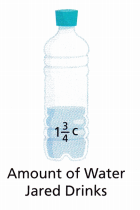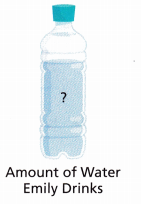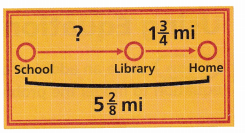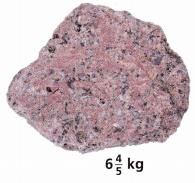We included HMH Into Math Grade 5 Answer Key PDF Module 7 Lesson 6 Practice Addition and Subtraction Using Equations to make students experts in learning maths.
HMH Into Math Grade 5 Module 7 Lesson 6 Answer Key Practice Addition and Subtraction Using Equations
I Can solve an addition or subtraction word problem by using an equation to model the problem.
Step It Out
1. After a run, Jared drinks 1\(\frac{3}{4}\) cups of water. His sister Emily drinks 1\(\frac{1}{2}\) cups more than Jared. How much water does Emily drink?

A. Draw bar models to represent the problem.
Amount Jared drinks
Amount Emily drinks
B. Write an equation to model how much water Emily drinks.
________________________________

C. Estimate the answer. ___________
D. Rename the mixed numbers with equivalent fractions using a common denominator. Then solve.
__________________________
E. How much water does Emily drink?
__________________________
F. Is your answer reasonable? Explain.
__________________________
Answer:
Given,
Jared drinks 1\(\frac{3}{4}\) cups of water.
His sister Emily drinks 1\(\frac{1}{2}\) cups more than Jared.
1\(\frac{3}{4}\) + 1\(\frac{1}{2}\)
Rewriting our equation with parts separated
1 + \(\frac{3}{4}\) + 1 + \(\frac{1}{2}\)
1 + 1 = 2
\(\frac{3}{4}\) + \(\frac{1}{2}\)
\(\frac{3}{4}\) + \(\frac{2}{4}\) = \(\frac{5}{4}\) = 1 \(\frac{1}{4}\)
2 + 1 \(\frac{1}{4}\) = 3\(\frac{1}{4}\)
Thus Emily drink 3\(\frac{1}{4}\) cups of water.
Turn and Talk Why is it a good idea to estimate the answer to a math problem?
Answer: Estimation can give you a quick way to check that your answer makes sense.
Step It Out
2. After school, Sandra walks to the library. Then she walks home. What is the distance from the school to the library?

A. Write an addition equation and a related subtraction equation to model the problem. Use d for the distance from the school to the library.
_____________________
B. Estimate the answer. ________
C. Rename the mixed numbers as equivalent fractions with a common denominator. Then find the distance from the school to the library. Explain the process you use.
__________________________
__________________________
__________________________
D. Is your answer reasonable? Explain.
__________________________
Answer:
d + 1\(\frac{3}{4}\) = 5 \(\frac{2}{8}\)
d = 5 \(\frac{2}{8}\) – 1\(\frac{3}{4}\)
Rewriting our equation with parts separated
5 + \(\frac{2}{8}\) – 1 – \(\frac{3}{4}\)
5 – 1 = 4
\(\frac{2}{8}\) – \(\frac{3}{4}\)
LCD is 8.
\(\frac{2}{8}\) – \(\frac{6}{8}\) = –\(\frac{4}{8}\) = –\(\frac{1}{2}\)
4 – \(\frac{1}{2}\) = 3\(\frac{1}{2}\)
d = 3\(\frac{1}{2}\) miles
So, the distance from school to the library is 3\(\frac{1}{2}\) miles.
Check Understanding Math Board
Question 1.
The Bakers spend 4\(\frac{1}{2}\) hours at the beach. They spend 2\(\frac{3}{5}\) hours in the water, and the rest of the time on land. Write an addition equation and a related subtraction equation to find t, the amount of time they spend on land. How much time do the Bakers spend on land?
Answer:
Given,
The Bakers spend 4\(\frac{1}{2}\) hours at the beach.
They spend 2\(\frac{3}{5}\) hours in the water, and the rest of the time on land.
t + 2\(\frac{3}{5}\) = 4\(\frac{1}{2}\)
t = 4\(\frac{1}{2}\) – 2\(\frac{3}{5}\)
Rewriting our equation with parts separated
4\(\frac{1}{2}\) – 2\(\frac{3}{5}\)
4 + \(\frac{1}{2}\) – 2 – \(\frac{3}{5}\)
4 – 2 = 2
\(\frac{1}{2}\) – \(\frac{3}{5}\)
LCD is 10
\(\frac{5}{10}\) – \(\frac{6}{10}\) = –\(\frac{1}{10}\)
2 – \(\frac{1}{10}\) = 1\(\frac{9}{10}\)
Thus the amount of time they spend on land is 1\(\frac{9}{10}\) hours
Question 2.
Lexi takes photos of food for magazine ads. At a photo shoot, she spends \(\frac{5}{6}\) hour arranging the food and 1\(\frac{3}{4}\) hours taking photos of the food. Write an equation to model the number of hours Lexi spends at the photo shoot. How many hours is she at the photo shoot?
Answer:
Given,
Lexi takes photos of food for magazine ads. At a photo shoot, she spends \(\frac{5}{6}\) hour arranging the food and 1\(\frac{3}{4}\) hours taking photos of the food.
\(\frac{5}{6}\) + 1\(\frac{3}{4}\)
\(\frac{5}{6}\) + 1 + \(\frac{3}{4}\)
\(\frac{5}{6}\) + \(\frac{3}{4}\)
LCD is 12.
\(\frac{10}{12}\) + \(\frac{9}{12}\) = \(\frac{19}{12}\)
1 + \(\frac{19}{12}\) = 2\(\frac{7}{12}\)
On Your Own
Question 3.
Model with Mathematics Jason makes a kite that is 3\(\frac{7}{12}\) feet tall. Anne makes a kite that is 1\(\frac{1}{4}\) feet taller than Jason’s kite. Draw a model to represent the problem and write an equation. How tall is Anne’s kite?

Answer:
Given,
Jason makes a kite that is 3\(\frac{7}{12}\) feet tall.
Anne makes a kite that is 1\(\frac{1}{4}\) feet taller than Jason’s kite.
3\(\frac{7}{12}\) + 1\(\frac{1}{4}\)
Rewriting our equation with parts separated
3 + \(\frac{7}{12}\) + 1 + \(\frac{1}{4}\)
3 + 1 = 4
\(\frac{7}{12}\) + \(\frac{1}{4}\)
LCD is 12
\(\frac{7}{12}\) + \(\frac{3}{12}\) = \(\frac{10}{12}\) = \(\frac{5}{6}\)
4 + \(\frac{5}{6}\) = 4\(\frac{5}{6}\)
Thus Anne’s kite is 4\(\frac{5}{6}\) feet tall.
Question 4.
Use Structure David has 3\(\frac{1}{4}\) cups of flour. He needs \(\frac{2}{3}\) cup to make biscuits and another 2\(\frac{3}{4}\) cups to make baguettes. Does David have enough flour? How much flour does David need or have left? Explain.
Answer:
Given,
David has 3\(\frac{1}{4}\) cups of flour.
He needs \(\frac{2}{3}\) cup to make biscuits and another 2\(\frac{3}{4}\) cups to make baguettes.
\(\frac{2}{3}\) + 2\(\frac{3}{4}\)
Rewriting our equation with parts separated
\(\frac{2}{3}\) + \(\frac{3}{4}\)
LCD is 12.
\(\frac{9}{12}\) + \(\frac{8}{12}\) = \(\frac{17}{12}\) = 1 \(\frac{5}{12}\)
2 + 1 \(\frac{5}{12}\) = 3 \(\frac{5}{12}\)
He has enough flour.
3 \(\frac{5}{12}\) – 3\(\frac{1}{4}\)
Rewriting our equation with parts separated
3 + \(\frac{5}{12}\) – 3 – \(\frac{1}{4}\)
3 – 3 = 0
\(\frac{5}{12}\) – \(\frac{1}{4}\)
LCD is 12
\(\frac{5}{12}\) – \(\frac{3}{12}\) = \(\frac{2}{12}\) = \(\frac{1}{6}\)
\(\frac{1}{6}\) fraction of the flour is left.
Question 5.
Mr. Lee’s house has two stories and an attic. The first floor is 9\(\frac{1}{2}\) feet high, the second floor is 8\(\frac{3}{4}\) feet high, and the entire house is 24\(\frac{7}{12}\) feet high. What is the height of the attic?
Answer:
Given,
Mr. Lee’s house has two stories and an attic. The first floor is 9\(\frac{1}{2}\) feet high, the second floor is 8\(\frac{3}{4}\) feet high, and the entire house is 24\(\frac{7}{12}\) feet high.
Entire house = F1 + F2 + Attic
24\(\frac{7}{12}\) = 9\(\frac{1}{2}\) + 8\(\frac{3}{4}\) + A
A = 24\(\frac{7}{12}\) – 9\(\frac{1}{2}\) – 8\(\frac{3}{4}\)
Rewriting our equation with parts separated
24 + \(\frac{7}{12}\) – 9 – \(\frac{1}{2}\) – 8 – \(\frac{3}{4}\)
24 – 9 – 8 = 7
\(\frac{7}{12}\) – \(\frac{1}{2}\) – \(\frac{3}{4}\)
\(\frac{7}{12}\) – \(\frac{6}{12}\) – \(\frac{9}{12}\) = –\(\frac{8}{12}\) = –\(\frac{2}{3}\)
7 – \(\frac{2}{3}\) = 6\(\frac{1}{3}\)
Thus the height of the attic is 6\(\frac{1}{3}\) feet.
Model with Mathematics For 6 and 7, write an addition equation and a related subtraction equation to model the problem. Then solve the problem.
Question 6.
Roberta works on a science project for 6\(\frac{1}{6}\) hours. Her friend Jocelyn works on the project for 2\(\frac{2}{4}\) hours longer than Roberta. How long does Jocelyn work on the science project?
Answer:
Given,
Roberta works on a science project for 6\(\frac{1}{6}\) hours.
Her friend Jocelyn works on the project for 2\(\frac{2}{4}\) hours longer than Roberta.
6\(\frac{1}{6}\) + 2\(\frac{2}{4}\)
Rewriting our equation with parts separated
6 + \(\frac{1}{6}\) + 2 + \(\frac{2}{4}\)
6 + 2 = 8
\(\frac{1}{6}\) + \(\frac{2}{4}\)
LCD is 12.
\(\frac{2}{12}\) + \(\frac{6}{12}\) = \(\frac{8}{12}\) = \(\frac{2}{3}\)
8 + \(\frac{2}{3}\) = 8\(\frac{2}{3}\)
Question 7.
A cricket jumps away from a frog. Then it takes a second jump. How many inches is the cricket’s first jump?

Answer:
Given,
12\(\frac{1}{4}\) – 9\(\frac{6}{8}\)
Rewriting our equation with parts separated
12 – 9 = 3
\(\frac{1}{4}\) – \(\frac{6}{8}\) = –\(\frac{4}{8}\) = –\(\frac{1}{2}\)
3 – \(\frac{1}{2}\) = 2\(\frac{1}{2}\) inches.
Question 8.
Reason Lauren measures 2\(\frac{1}{4}\) cups of flour for a recipe. She then realizes she needs to add \(\frac{2}{3}\) cup of flour. Does Lauren use more than or less than 3 cups of flour? Explain.
Answer:
Given,
Lauren measures 2\(\frac{1}{4}\) cups of flour for a recipe.
She then realizes she needs to add \(\frac{2}{3}\) cup of flour.
2\(\frac{1}{4}\) + \(\frac{2}{3}\)
Rewriting our equation with parts separated
2 + \(\frac{1}{4}\) + \(\frac{2}{3}\)
\(\frac{1}{4}\) + \(\frac{2}{3}\)
LCD is 12
\(\frac{3}{12}\) + \(\frac{8}{12}\) = \(\frac{11}{12}\)
2 + \(\frac{11}{12}\) = 2\(\frac{11}{12}\)
Lauren use less than 3 cups of flour.
Question 9.
Model with Mathematics A piece of quartz has a mass that is 2\(\frac{1}{2}\) kilograms greater than the mass of the granite. Write an equation to model the mass of the quartz. What is the mass of the quartz?

Answer:
Given,
A piece of quartz has a mass that is 2\(\frac{1}{2}\) kilograms greater than the mass of the granite.
2\(\frac{1}{2}\) + 6\(\frac{4}{5}\)
Rewriting our equation with parts separated
2 + \(\frac{1}{2}\) + 6 + \(\frac{4}{5}\)
2 + 6 = 8
\(\frac{1}{2}\) + \(\frac{4}{5}\)
LCD of 2 and 5 is 10.
\(\frac{5}{10}\) + \(\frac{8}{10}\) = \(\frac{13}{10}\) = 1\(\frac{3}{10}\)
8 + 1\(\frac{3}{10}\) = 9\(\frac{3}{10}\)
Thus the mass of quarts is 9\(\frac{3}{10}\)